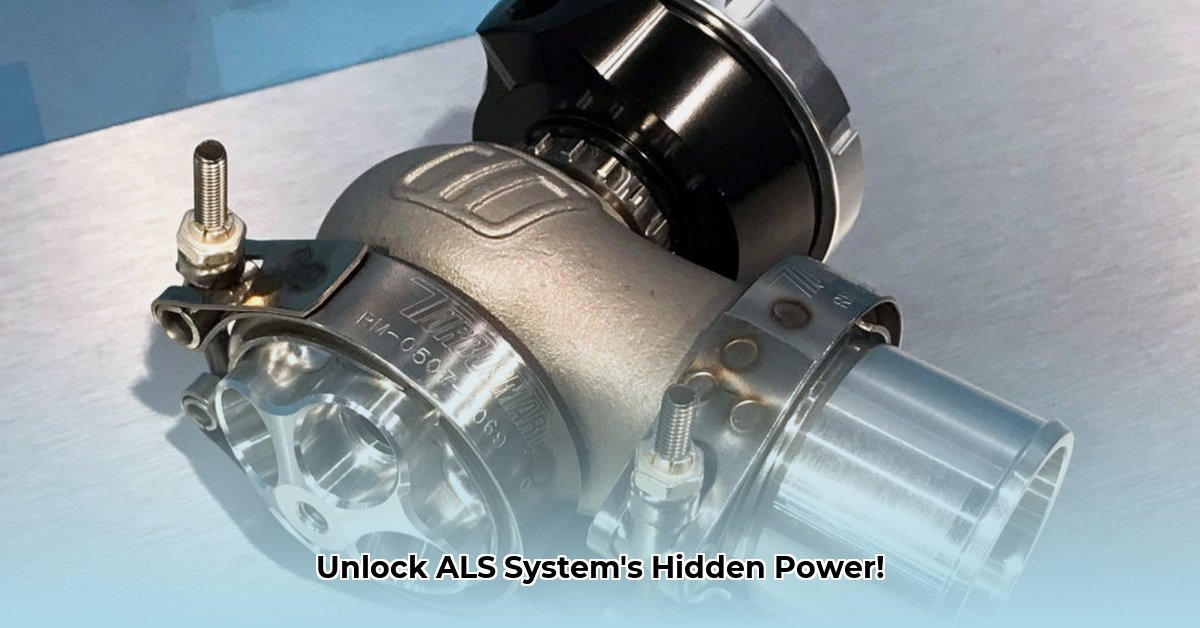
ALS System Turbo: Unleashing Power in Motorsports
Turbo lag—that frustrating delay between accelerating and feeling the power—is the enemy of performance enthusiasts. Anti-lag systems (ALS) for turbochargers are designed to obliterate this lag, dramatically improving acceleration. ALS achieves this by manipulating fuel injection, ignition timing, and exhaust gases, essentially creating controlled explosions to keep the turbo spinning faster. Think of it as a controlled pre-ignition burst to get the turbo spooling. This guide will explore the intricacies of ALS technology and provide actionable steps to harness its power safely and effectively.
Early ALS systems were largely mechanical and prone to issues. Modern systems, however, leverage sophisticated electronics for precise control, maximizing performance while minimizing engine wear. This evolution is a testament to the ongoing quest for higher performance and efficiency.
How ALS System Turbo Technology Works: Under the Hood
Several methods achieve faster turbo spool-up. ALS systems typically fine-tune fuel injection and ignition timing. Some even inject fuel directly into the exhaust manifold, even with a closed throttle. These mini-explosions spin the turbine faster—a direct boost to turbo response.
Some ALS systems bypass the throttle entirely, directly routing exhaust gases to the turbine. Others utilize more refined approaches, but the core principle remains consistent: controlling exhaust flow to generate energy for instant acceleration. Each approach presents unique advantages and drawbacks, which we will examine in detail.
Weighing the Pros and Cons of ALS System Turbos
Before implementation, a thorough assessment of the trade-offs is essential. ALS systems offer substantial benefits, but potential downsides must be considered.
| Feature | Pros | Cons |
|---|---|---|
| Performance | Significantly reduced turbo lag; noticeable low-end torque increase; quicker acceleration | Increased engine wear; potentially higher emissions; risk of component damage |
| Complexity | Advanced systems offer fine-tuned control and performance optimization | Requires specialized tuning and more frequent, specialized maintenance |
| Cost | Significant performance gains | High initial installation costs and ongoing maintenance expenses |
| Environmental Impact | Can lead to higher emissions in certain configurations | Ongoing R&D aims to minimize environmental impact |
This table highlights the key considerations. While the performance improvements are substantial, understanding the potential drawbacks and planning accordingly is crucial.
The Evolution of ALS Turbo Technology: From Clunky to Cutting-Edge
Early ALS systems were notoriously rough, producing loud, violent power bursts and significant engine stress. Modern systems, however, are far more sophisticated. Precise electronic controls smooth power delivery, substantially reducing wear and tear. Nevertheless, balancing maximum power with engine longevity remains an ongoing challenge.
Modern Formula 1 teams utilize hybrid systems to further minimize lag and reduce dependence on solely mechanical ALS techniques. This showcases the innovative approaches being explored in this continuously evolving field.
The Future of ALS System Turbos: What's on the Horizon?
Future ALS technology will likely involve even more efficient systems that minimize environmental impact without sacrificing performance. Advancements in materials science promise more durable engines capable of withstanding the increased stresses of ALS operation. The pursuit of ultimate performance is continuous, with ongoing innovation pushing the boundaries of what's possible.
How to Minimize Engine Wear from Anti-Lag Systems in Motorsport
Key Takeaways:
- ALS drastically improves acceleration but significantly increases engine wear.
- Understanding ALS operation is crucial for mitigating damage.
- Careful tuning, preventative maintenance, and robust components are vital.
- Emerging technologies offer less destructive alternatives to traditional ALS.
Does maximizing performance require sacrificing engine longevity? The answer is a resounding "no," with careful attention to detail.
Understanding Anti-Lag Systems (ALS)
ALS, designed to eliminate turbo lag, keeps the turbo spinning even when the throttle is closed. This is achieved by strategically injecting fuel into the exhaust stream creating controlled explosions that maintain turbine speed. This process, however, creates intense heat and pressure, inherently increasing engine wear.
How ALS Works: A Simplified Explanation
Think of a spinning top. When you stop pushing, it slows down. A turbocharger functions similarly. ALS keeps the "top" spinning by creating controlled explosions in the exhaust stream. This process generates intense heat and pressure, making component wear a significant concern. How can we mitigate this? Let's explore practical strategies.
Minimizing ALS-Induced Engine Wear: Practical Strategies
Optimize ALS Settings: Fine-tune ALS parameters to match vehicle needs and operating conditions. Less aggressive settings reduce wear but may compromise some performance. How can we strike the optimal balance? Careful monitoring is vital.
Choose Robust Components: Invest in high-quality turbochargers, exhaust manifolds, and related parts designed to withstand higher stresses. These components often utilize advanced materials for enhanced durability. What materials are best suited? Consult with specialized suppliers for the latest information.
Preventive Maintenance: Implement a rigorous maintenance schedule with regular inspections for cracks, leaks, or excessive wear. Timely replacements prevent catastrophic failures. How frequently should I conduct these inspections? This frequency depends on intensity of use and specific components.
Data Logging & Analysis: Use data loggers to monitor key parameters (turbocharger speed, exhaust gas temperature, engine pressures). This allows fine adjustment of the ALS system to minimize strain and identify optimal settings for maximum performance while minimizing risk of component damage. What data points should I prioritize? Consult your ALS system’s documentation and utilize expert advice from experienced tuners.
Explore Alternative Technologies: Emerging technologies like EGR systems provide alternative methods for boost management and improved throttle response, often with less engine wear. What are the key differences between traditional ALS and alternative technologies? Thorough research is needed for informed decision-making.
The Importance of Regular Inspections and Maintenance
Regular inspections are paramount. Early detection of potential problems prevents costly repairs and catastrophic failures. How often are these essential inspections? Regularity depends on the ALS system's intensity and usage. Consult expert advice for system-specific guidance.
A Balanced Approach: Performance vs. Longevity
The goal is an equilibrium between performance enhancement and maintaining engine longevity. Aggressive ALS settings may provide an edge, but they drastically shorten component lifespan. Through careful tuning, maintenance, and component selection, long-term performance and engine health can be achieved.